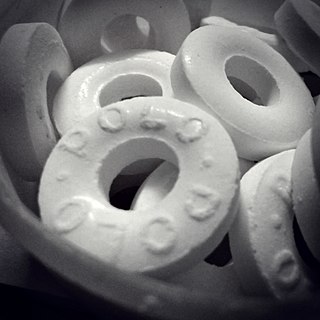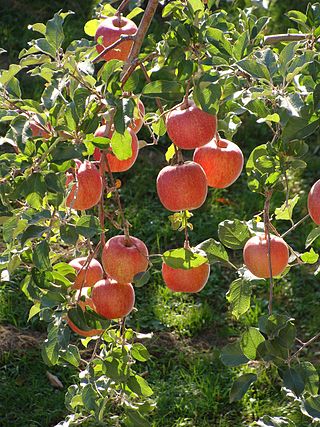Related Research Articles

Cashew is the common name of a tropical evergreen tree Anacardium occidentale, in the family Anacardiaceae. It is native to South America and is the source of the cashew nut and the cashew apple, an accessory fruit. The tree can grow as tall as 14 metres, but the dwarf cultivars, growing up to 6 m (20 ft), prove more profitable, with earlier maturity and greater yields. The cashew nut is edible and is eaten on its own as a snack, used in recipes, or processed into cashew cheese or cashew butter. The nut is often simply called a 'cashew'. Cashew can cause allergies triggered by the proteins found in the nuts.

The pomegranate is a fruit-bearing deciduous shrub in the family Lythraceae, subfamily Punicoideae, that grows between 5 and 10 m tall. The pomegranate is rich in symbolic and mythological associations in many cultures.

A grocery store (AE), grocery shop (BE) or simply grocery is a foodservice retail store that primarily retails a general range of food products, which may be fresh or packaged. In everyday U.S. usage, however, "grocery store" is a synonym for supermarket, and is not used to refer to other types of stores that sell groceries. In the UK, shops that sell food are distinguished as grocers or grocery shops (though in everyday use, people usually use either the term "supermarket" or a "corner shop".

Squash, is a non-alcoholic beverage with syrup used in beverage making. It is usually fruit-flavoured, made from fruit juice, water, and sugar or a sugar substitute. Modern squashes may also contain food colouring and additional flavouring. Some traditional squashes contain herbal extracts, most notably elderflower and ginger.

Mangosteen, also known as the purple mangosteen, is a tropical evergreen tree with edible fruit native to Island Southeast Asia, from the Malay Peninsula to Borneo. It has been cultivated extensively in tropical Asia since ancient times. It is grown mainly in Southeast Asia, southwest India and other tropical areas such as Colombia, Puerto Rico and Florida, where the tree has been introduced. The tree grows from 6 to 25 m tall.

The Granny Smith, also known as a green apple or sour apple, is an apple cultivar that originated in Australia in 1868. It is named after Maria Ann Smith, who propagated the cultivar from a chance seedling. The tree is thought to be a hybrid of Malus sylvestris, the European wild apple, with the domesticated apple Malus domestica as the polleniser.

The loquat is a large evergreen shrub or tree grown commercially for its orange fruit and for its leaves, which are used to make herbal tea. It is also cultivated as an ornamental plant.

Polo is a brand of breath mint whose defining feature is the hole in the middle. The peppermint flavoured Polo was first manufactured in the United Kingdom in 1948, by employee John Bargewell at the Rowntree's Factory, York, and a range of flavours followed. The name may derive from "polar", referencing the cool, fresh taste of the mint. Polo mints are also sold in other countries such as India and Sri Lanka by Nestlé. Polo mints are usually sold in a 34g pack containing 23 individual mints.
Budgens Stores Limited, trading as Budgens, is a chain of grocery stores in the United Kingdom. The business was founded in 1872 by John Budgen, who opened the first shop in Maidenhead, Berkshire and was incorporated as a private limited company on 28 May 1962. The company is a subsidiary and retail fascia of Booker Group, part of Tesco plc.

The Fuji apple is an apple cultivar developed by growers at the Tōhoku Research Station of the Ministry of Agriculture and Forestry in Fujisaki, Aomori, Japan, in the late 1930s, and brought to market in 1962. It originated as a cross between two American apple varieties—the Red Delicious and old Virginia Ralls Janet apples. According to the US Apple Association website it is one of the nine most popular apple cultivars in the United States. Its name is derived from the first part of the town where it was developed: Fujisaki.

Gravenstein is a triploid apple cultivar that originated in the 17th century or earlier. The fruit has a tart flavor, and it is heavily used as a cooking apple, especially for apple sauce and apple cider. It does not keep well, and it is available only in season. This is in part because neither cold storage, nor regular controlled atmosphere keeps the apples' distinctive aroma, although the Nova Scotia Fruit Growers' Association states that "recently however, low oxygen CA storage has shown promise in retaining this harvest-time quality".

Glass milk bottles are glass bottles used for milk. They are reusable and returnable – used mainly for doorstep delivery of fresh milk by milkmen. Once customers have finished the milk, empty bottles are expected to be rinsed and left on the doorstep for collection, or rinsed bottles may be returned to a participating retail store. Bottle sizes vary depending on region, but common sizes include pint, quart or litre.

Honeycrisp is an apple cultivar developed at the Minnesota Agricultural Experiment Station's Horticultural Research Center at the University of Minnesota, Twin Cities. Designated in 1974 with the MN 1711 test designation, patented in 1988, and released in 1991, the Honeycrisp, once slated to be discarded, has rapidly become a prized commercial commodity, as its sweetness, firmness, and tartness make it an ideal apple for eating raw. "...The apple wasn't bred to grow, store or ship well. It was bred for taste: crisp, with balanced sweetness and acidity." It has larger cells than most apple cultivars, a trait which is correlated with juiciness, as larger cells are more prone to rupturing instead of cleaving along the cell walls; this rupturing effect is likely what makes the apple taste juicier. The Honeycrisp also retains its pigment well and has a relatively long shelf life when stored in cool, dry conditions. Pepin Heights Orchards delivered the first Honeycrisp apples to grocery stores in 1997. The name Honeycrisp was trademarked by the University of Minnesota, but university officials were unsure of its protection status in 2007. It is now the official state fruit of Minnesota. A large-sized honeycrisp will contain about 113 calories.

Hi-C is an American fruit juice-flavored drink made by the Minute Maid division of The Coca-Cola Company. It was created by Niles Foster in 1946 and released in 1947. The sole original flavor was orange.

Cripps Pink is a cultivar of apple. It is one of several cultivars sold under the trade mark name Pink Lady. It was originally bred by John Cripps at the Western Australia Department of Agriculture, by crossing the Australian apple Lady Williams with a Golden Delicious; the result is a combination of the firm, long-storing property of Lady Williams with the sweetness and lack of storage scald of Golden Delicious.

The tomato is the edible berry of the plant Solanum lycopersicum, commonly known as the tomato plant. The species originated in western South America, Mexico, and Central America. The Nahuatl word tomatl gave rise to the Spanish word tomate, from which the English word tomato derives. Its domestication and use as a cultivated food may have originated with the indigenous peoples of Mexico. The Aztecs used tomatoes in their cooking at the time of the Spanish conquest of the Aztec Empire, and after the Spanish encountered the tomato for the first time after their contact with the Aztecs, they brought the plant to Europe, in a widespread transfer of plants known as the Columbian exchange. From there, the tomato was introduced to other parts of the European-colonized world during the 16th century.

Gristedes is a New York City–based chain of supermarkets. It serves a mostly urban customer base.

An apple is a round, edible fruit produced by an apple tree. Apple trees are cultivated worldwide and are the most widely grown species in the genus Malus. The tree originated in Central Asia, where its wild ancestor, Malus sieversii, is still found. Apples have been grown for thousands of years in Eurasia and were introduced to North America by European colonists. Apples have religious and mythological significance in many cultures, including Norse, Greek, and European Christian tradition.

Cider is an alcoholic beverage made from the fermented juice of apples. Cider is widely available in the United Kingdom and Ireland. The UK has the world's highest per capita consumption, as well as the largest cider-producing companies. Ciders from the South West of England are generally higher in alcoholic content. Cider is also popular in many Commonwealth countries, such as India, South Africa, Canada, Australia, and New Zealand. As well as the UK and its former colonies, cider is popular in Portugal, France, Friuli, and northern Spain. Germany also has its own types of cider with Rhineland-Palatinate and Hesse producing a particularly tart version known as Apfelwein. In the U.S. and Canada, varieties of alcoholic cider are often called hard cider to distinguish it from non-alcoholic apple cider or "sweet cider", also made from apples. In Canada, cider cannot contain less than 2.5% or over 13% absolute alcohol by volume.

Aurora Golden Gala is a cross between the apples 'Splendour' and 'Gala'. It was named in 2003 in a nationwide "Name the Apple" contest. Aurora Golden Gala is a yellow dessert apple. It is harvested mid-season. The fruit are medium in size, very crisp, juicy, aromatic, sweet, and they store well.
References
- ↑ "Province of British Columbia - Tree Fruit Variety Information" (PDF). Gov BC Agriculture. pp. 7–8. Archived from the original (PDF) on 13 March 2017. Retrieved 14 June 2016.